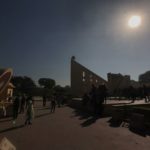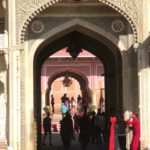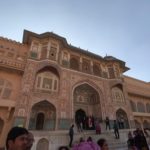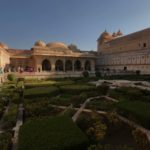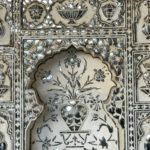Udaipur to Jaipur – 434 km (overnight train)
& 30483 Fit Bit steps
Old Jaipur, “the pink city”, laid out in a grid system, appears more recently established than the late 1700’s, when it was designed. Jai Singh II was a man of science and mathematics and the form of the city that he built reflects this. During the rule of Sawai Ram Singh I, the city was painted pink to welcome the Prince of Wales, later Edward VII, in 1876.
A walking tour from the Lonely Planet guide took us through the many busy bazaars of the old city, each section specializing in a specific commodity. In the clothing bazaar, we saw brightly coloured sari material being shown to groups of women sitting on the floor of the small open-fronted shops. From the top of the Iswari Minar Swarga Sal minaret, we had a good view of the City Palace and the surrounding Aravali range.The City Palace includes the Mubarak Mahal, a reception centre for foreign dignitaries built with Hindu, Muslim and European styles. The Jantar Mantar is another of Jai Singh’s works. Like one we had seen in Delhi built by him, it is a collection of accurately set sundials and devices to show the positions of the stars and planets and asssociated signs of the zodiac.
The nearby hills are topped by a series of forts and palaces established by the Maharajahs before the capital was moved from Amber. The Nahargarh Fort, built in 1734, and the Jaigarh fort of 1726 are perched on the cliff close to the Amber (pronounced « amer ») Fort, built in 1592. The Nahargarh fort was hosting a very interesting sculpture exhibit, Sculpture Park. The Amber fort is a fine building in pink and yellow sandstone and white marble. It is laid out on four levels, each with its own courtyard, with reception halls and quarters for the Maharajah and Maharanis. An old stone wall joining the forts and other guard posts snakes its way for 15km around the forts. In the valley below, the water palace (Jal Mahal) on the outskirts of the city was believed to have been built by Jai Singh II. It is isolated on a lake with no apparent connection to the shore, which adds to its charm. Today’s India was also illustrated by a new modern temple with attractive stained glass windows, built by a local business person.
We visited these sights on a city bus tour with a group of Indian tourists. Although, we later found out that one of the Sikh men on our tour lives in Vancouver! At ticket booths, the distinction is clear with markedly higher fees for foreigners. This even applied to the simple Thali meal included with the tour ticket!
In Jaipur, we found the best espresso in India by far at Curious Life. The hipster shop would not have been out of place in downtown Vancouver, apart from the fact that the locally roasted coffee was all from India. Thanks to Longly Planet for this and also for directing us to Anokhi where we picked up some cute clothes for our grandchildren and a shirt for Paul.








